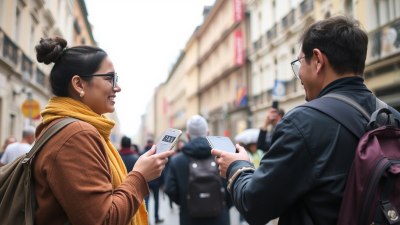What to Say When a Local Asks for Directions
Helpful phrases and tips for giving directions to locals. Navigate conversations with ease!

When traveling or exploring a new city, it's common to encounter locals who may ask for directions. Being prepared with the right responses can not only help them but also enrich your travel experience. Here, we delve into various scenarios and phrases that can assist you effectively.
Understanding the Local Context
Before you utter any words, it’s essential to understand local customs and the way directions are typically given. In some cultures, it's all about landmarks, while in others, it may be about street names and compass directions. Becoming familiar with the local language basics, even just greetings and thank you phrases, will also go a long way in making the interaction smoother.
For example, if you’re in a city that heavily relies on public transportation, such as the subway or bus systems, locals might ask how to reach a particular station or stop. You may want to clarify if they prefer walking, taking public transport, or driving to get a clearer picture of what type of directions to provide.
Basic Phrases to Use
When approached by someone asking for directions, start with a friendly greeting. A simple “Hello” or “Hi” sets a positive tone. Here are some phrases that you might find useful:
- “Sorry, I’m not from around here. But I can help you with some basics!”
- “Sure! Where are you trying to go?”
- “Let me see if I can help you with directions.”
It’s important to listen carefully to their request, which may include the name of a place, a street, or a specific building. If necessary, you can ask them to repeat themselves, gently saying, “Could you please repeat that?”
Giving Directions: Landmarks vs. Streets
Illustrating the way using local landmarks is often more intuitive. Here’s how you could phrase it:
- “You’ll want to head towards the park; it’s right next to the library.”
- “Go past the old church, and you’ll see the museum on your left.”
In contrast, if the area is more organized using street names, try phrases like:
- “Take a left on Maple Street and continue straight until you reach Oak Avenue.”
- “You’re going to want to go down Fifth Avenue and turn right at the next stoplight.”
In any case, indicate directions clearly—whether it's 'left', 'right', 'straight', or 'back'—and keep your tone friendly to maintain a pleasant exchange.
Using Visual Aids
Whenever possible, if you have a map or a smartphone, offering to show them directions visually can enhance understanding. Here’s how to express this:
- “I have a map; let’s look at it together.”
- “Do you have a GPS or a smartphone? I can help you find it.”
Visually mapping out their route is often more effective than verbal descriptions alone. Furthermore, be mindful that not everyone may be comfortable using tech, so remain patient and understanding of their needs.
Dealing with Language Barriers
Language barriers can complicate conversations. If you're in a country where you don’t speak the language fluently, try using simple, straightforward words. You can also use gestures like pointing or mimicking movements to convey directions. Here’s how you might phrase this:
- “I can’t speak your language, but I can point it out for you.”
- “Follow my finger; I’ll show you the way.”
Using a translation app can also ease communication significantly. Simple expressions such as “This way,” or using pictures of the locations can be beneficial.
When You Don’t Know the Answer
Sometimes, despite your best efforts, you might not know the answer. Instead of guessing, be honest:
- “I’m sorry, but I’m not quite sure.”
- “Unfortunately, I don’t know the area well enough to help.”
Offer to help them find someone who does, suggesting, for example, “Let’s ask someone over there for directions.” This not only demonstrates goodwill but also steers the local in the right direction.
Polite Closing Statements
To end the conversation positively, use polite phrases. Consider saying:
- “I hope you find it!”
- “Good luck, and have a great day!”
These courteous remarks help foster a sense of community and friendliness, creating positive island memories for both of you.
Practicing Your Skills
To get better at giving directions, practice makes perfect! Role-play scenarios with friends or family, either at home or when you come across real-life situations. Try rehearsing with friends before a trip, and even make a list of common places that often come up in local inquiries. The more you practice, the more comfortable you become! People greatly appreciate an effort, even if your language skills are not perfect.
Exploring More Complex Directions
As you gain confidence, you might tackle more complex directions. When the person you’re assisting has a more intricate destination, break the directions down into segments:
- “First, go straight for two blocks.”
- “Then turn left at the traffic lights.”
- “Finally, you should see the grocery store on your right before crossing Main Street.”
This step-by-step format provides clarity, especially in busy or confusing environments.
Building Confidence
With practice and experience, your confidence in giving directions will grow. It’s okay to make mistakes—what’s important is the willingness to engage and assist locals! Each interaction is also an opportunity to learn something new. Pay attention to how others give directions, practicing their techniques and integrating them into your style.
Conclusion
When locals ask for directions, it's a chance for cultural exchange and learning. Every interaction is unique, and with the right phrases and a friendly disposition, you can create positive experiences for both you and the person seeking help. Remember to stay patient, listen carefully, and communicate clearly. The art of giving directions is not just about the destination; it's about connecting with others. Happy travels and good luck with your navigational encounters!











